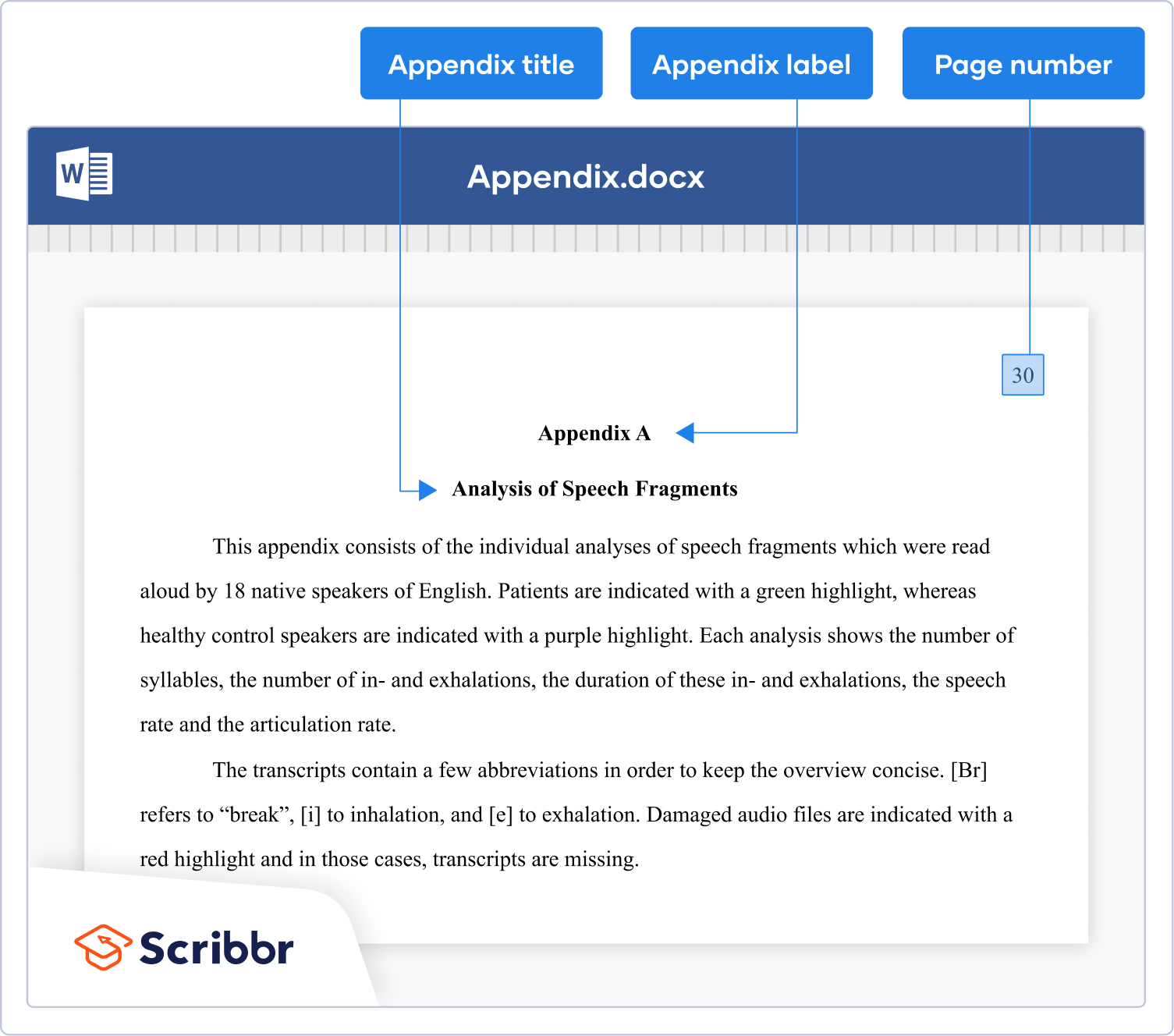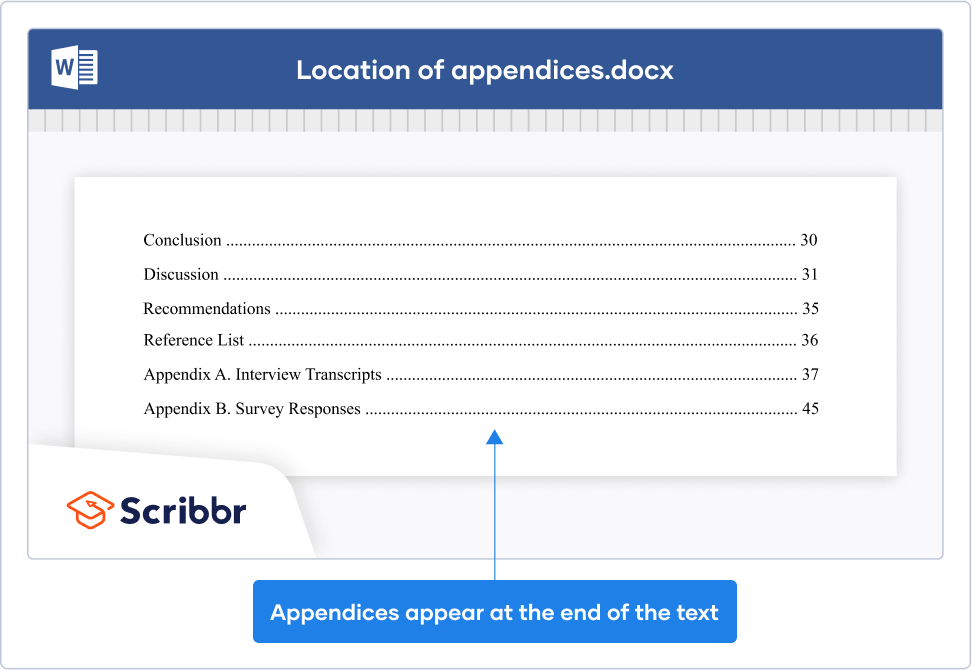Research Paper Appendix | Example & Templates
An appendix is a supplementary document that facilitates your reader’s understanding of your research but is not essential to your core argument. Appendices are a useful tool for providing additional information or clarification in a research paper, dissertation, or thesis without making your final product too long.
Appendices help you provide more background information and nuance about your topic without disrupting your text with too many tables and figures or other distracting elements.
We’ve prepared some examples and templates for you, for inclusions such as research protocols, survey questions, and interview transcripts. All are worthy additions to an appendix. You can download these in the format of your choice below.
Download Word doc Download Google doc
What is an appendix in a research paper?
In the main body of your research paper, it’s important to provide clear and concise information that supports your argument and conclusions. However, after doing all that research, you’ll often find that you have a lot of other interesting information that you want to share with your reader.
While including it all in the body would make your paper too long and unwieldy, this is exactly what an appendix is for.
As a rule of thumb, any detailed information that is not immediately needed to make your point can go in an appendix. This helps to keep your main text focused but still allows you to include the information you want to include somewhere in your paper.
In other words, appendices only serve to provide additional or supplemental information, and deciding what to include in your paper can be a bit of a balancing act.
What to include in an appendix
An appendix can be used for different types of information, such as:
- Supplementary results: Research findings are often presented in different ways, but they don’t all need to go in your paper. The results most relevant to your research question should always appear in the main text, while less significant results (such as detailed descriptions of your sample or supplemental analyses that do not help answer your main question), can be put in an appendix.
- Statistical analyses: If you conducted statistical tests using software like Stata or R, you may also want to include the outputs of your analysis in an appendix.
- Further information on surveys or interviews: Written materials or transcripts related to things such as surveys and interviews can also be placed in an appendix.
How to format an appendix
You can opt to have one long appendix, but separating components (like interview transcripts, supplementary results, or surveys) into different appendices makes the information simpler to navigate.
Here are a few tips to keep in mind:
- Always start each appendix on a new page.
- Assign it both a number (or letter) and a clear title, such as “Appendix A. Interview transcripts.” This makes it easier for your reader to find the appendix, as well as for you to refer back to it in your main text.
- Number and title the individual elements within each appendix (e.g., “Transcripts”) to make it clear what you are referring to. Restart the numbering in each appendix at 1.
How to refer to an appendix
It is important that you refer to each of your appendices at least once in the main body of your paper. This can be done by mentioning the appendix and its number or letter, either in parentheses or within the main part of a sentence. It’s also possible to refer to a particular component of an appendix.
Appendix B presents the correspondence exchanged with the fitness boutique.
Table 1 in Appendix 2 presents an overview of the correspondence with the fitness boutique.
It is common to capitalize “Appendix” when referring to a specific appendix, but it is not mandatory. The key is just to make sure that you are consistent throughout your entire paper, similarly to consistency in capitalizing headings and titles in academic writing.
However, note that lowercase should always be used if you are referring to appendices in general. For instance, “The appendices to this paper include additional information about both the survey and the interviews.”
Where to put your appendices
The simplest option is to add your appendices after the main body of your text, after you finish citing your sources in the citation style of your choice. If this is what you choose to do, simply continue with the next page number. Another option is to put the appendices in a separate document that is delivered with your dissertation.
Remember that any appendices should be listed in your paper’s table of contents.
Other components to consider
There are a few other supplementary components related to appendices that you may want to consider. These include:
- List of abbreviations: If you use a lot of abbreviations or field-specific symbols in your dissertation, it can be helpful to create a list of abbreviations.
- Glossary: If you utilize many specialized or technical terms, it can also be helpful to create a glossary.
- Tables, figures and other graphics: You may find you have too many tables, figures, and other graphics (such as charts and illustrations) to include in the main body of your dissertation. If this is the case, consider adding a figure and table list.
Appendix checklist
Checklist: Appendix
0 / 6Well done!
Your appendices look great! Use the other checklists to further improve your thesis.
See all other checklists Return to checklistFrequently asked questions about appendices
- Can I cite sources in an appendix?
-
Yes, if relevant you can and should include APA in-text citations in your appendices. Use author-date citations as you do in the main text.
Any sources cited in your appendices should appear in your reference list. Do not create a separate reference list for your appendices.
- What is an appendix?
-
An appendix contains information that supplements the reader’s understanding of your research but is not essential to it. For example:
- Interview transcripts
- Questionnaires
- Raw data
- Detailed descriptions of equipment
Something is only worth including as an appendix if you refer to information from it at some point in the text (e.g. quoting from an interview transcript). If you don’t, it should probably be removed.
- Where do appendices go in an APA Style paper?
-
Appendices in an APA Style paper appear right at the end, after the reference list and after your tables and figures if you’ve also included these at the end.
Sources in this article
We strongly encourage students to use sources in their work. You can cite our article (APA Style) or take a deep dive into the articles below.
This Scribbr articleGeorge, T. & Dingemanse, K. (September 29, 2022). Research Paper Appendix | Example & Templates. Scribbr. Retrieved October 19, 2022, from https://www.scribbr.com/research-paper/appendix/



